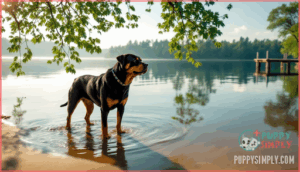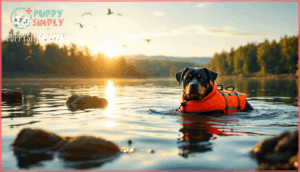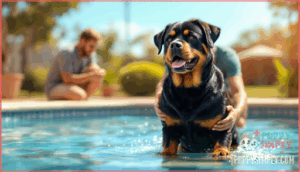This site is supported by our readers. We may earn a commission, at no cost to you, if you purchase through links.

Their barrel-chested, heavily muscled bodies weren’t exactly designed for graceful aquatic adventures. Most Rotties can technically swim using basic doggy paddle mechanics, but whether they’ll enjoy it depends on their individual personality, early experiences, and how you introduce them to water.
Some take to it surprisingly well with patient training, while others would rather guard the shore and keep their paws firmly on dry land.
Table Of Contents
- Key Takeaways
- Can Rottweilers Swim?
- Why Swimming Can Be Challenging for Rottweilers
- How to Teach Your Rottweiler to Swim
- Signs Your Rottweiler Likes or Dislikes Swimming
- Health Benefits and Safety Tips for Swimming Rottweilers
- Frequently Asked Questions (FAQs)
- Should I use a life jacket when my Rottweiler swims?
- Is it safe for my Rottweiler to swim in a lake, river, or ocean?
- How old should a Rottweiler puppy be before I try to teach it to swim?
- Can I take my Rottweiler swimming if it has arthritis or joint problems?
- Should I trim the fur on my Rottweiler before taking it swimming?
- What water temperature is safe for Rottweilers?
- How often should Rottweilers swim weekly?
- Can Rottweilers swim in saltwater or oceans?
- Do Rottweiler puppies need different swimming training?
- What breeds should not swim with Rottweilers?
- Conclusion
Key Takeaways
- Rottweilers can technically swim using instinctive dog paddle mechanics, but their barrel-chested, heavily muscled build creates real buoyancy challenges and causes them to tire much faster than water breeds like Labs or Newfoundlands.
- Success depends entirely on individual personality and early positive experiences—forcing a fearful Rottweiler into water backfires, while patient introduction with treats, life jackets, and shallow water builds confidence gradually.
- Swimming offers powerful joint-friendly exercise benefits for Rottweilers (especially those with arthritis), but sessions should start at just 10-15 minutes due to rapid fatigue from their muscle density.
- Critical safety requires life jackets, constant supervision, clear pool exits, and watching for warning signs like labored breathing, low-riding head, or weak paddling that signal dangerous exhaustion before drowning risk escalates.
Can Rottweilers Swim?
If you’ve been wondering whether your Rottweiler can take a dip, the short answer is yes—most can. But it’s not quite as simple as tossing them into the pool and calling it a day.
Let’s break down what makes swimming possible for Rotties, how they differ from natural water dogs, and why each dog’s story is unique.
Natural Swimming Instincts in Rottweilers
Like their wolf ancestors, Rottweilers carry the instinctive "dog paddle" reflex in their DNA—but that doesn’t mean they’ll plunge into with the same enthusiasm as a Labrador retriever. Most Rotties can swim using basic doggy paddle swimming techniques, but their genetic predisposition leans toward guarding and herding, not water work.
Breed characteristics—like their muscular frame—affect water acclimation. Individual canine instincts vary widely, so canine aquatic safety starts with understanding your dog’s comfort level before any pool time.
Differences From Water Breeds
Compared to water breeds, your Rottweiler faces a steeper climb. Labrador Retrievers and Newfoundlands come equipped with webbed feet, water-resistant double coats, and body structures fine-tuned for aquatic adaptation.
Rottweilers? Their barrel-chested build and muscle density work beautifully on land but create buoyancy issues in water. Breed comparison isn’t about what your dog can’t do—it’s about understanding the extra effort swimming demands from a herding breed versus one shaped by generations of water-based breeding.
With proper training and introduction to swimming ability, Rottweilers can learn to overcome their physical limitations and become proficient swimmers.
Individual Personality and Early Experiences
Your Rottweiler’s relationship with water isn’t written in stone—it’s shaped by temperament, confidence, and whether their first splash was a gentle introduction or an accidental shove off the dock. Early socialization matters enormously. Rottweiler puppies exposed to positive water experiences develop curiosity instead of fear.
Individual differences trump breed temperament—some dogs dive right in, while others need patient puppy training and gradual water introduction to build trust and overcome canine training challenges.
Why Swimming Can Be Challenging for Rottweilers
While Rottweilers can learn to swim, their physical makeup puts them at a disadvantage compared to breeds built for water. Their body type creates real obstacles that you’ll need to understand before introducing your dog to swimming.
Let’s break down the three main challenges that make swimming harder for Rotties.
Heavy, Muscular Build
Think of a Rottweiler as a bodybuilder trying to float—muscle density works against them. Males averaging 95–135 pounds carry considerably more muscle than fat, creating buoyancy challenges that demand serious energy expenditure just to stay afloat. Breed standards prioritize that powerful, barrel-chested build for strength, not swimming efficiency.
Rottweilers swim like bodybuilders trying to float—their muscular build demands serious energy just to stay afloat
This means training implications are real: your Rottweiler will tire faster than water-loving breeds, making supervision and rest breaks essential for safe aquatic adventures. To mitigate potential health issues, it’s vital to review the dog breed characteristics when engaging your Rottweiler in physical activities like swimming.
Shorter Legs and Body Structure
A Rottweiler’s leg-to-torso ratio complicates their swimming mechanics—proportionally shorter limbs mean they’re paddling harder to move that substantial frame through the water. Body proportions matter: those compact legs struggle to generate momentum against their muscle distribution and bone density.
Joint mobility helps, but breed characteristics still mean water safety precautions and dog swimming lessons become critical for teaching efficient paddling techniques that prevent exhaustion.
Thick Fur Coat and Buoyancy Issues
That double-layered coat—dense topcoat and insulating undercoat—turns into a waterlogged anchor the moment your Rottie hits the pool. Fur density creates buoyancy problems that compromise swimming technique.
- Saturated fur adds pounds, sinking your dog lower
- Water safety becomes critical as coat maintenance affects flotation
- Body structure already works against natural buoyancy
- Rottweilers need extra support compared to sleeker breeds
- Dog swimming lessons help compensate for these coat-related challenges
How to Teach Your Rottweiler to Swim
Teaching your Rottweiler to swim doesn’t have to feel like throwing them into the deep end. With patience and the right approach, you can help your dog gain confidence and skill in the water.
Here are three key strategies that’ll set you both up for success.
Positive Reinforcement and Treats
When you’re coaxing your Rottweiler into the water for the first time, the right reward can mean the difference between a confident swimmer and a dog who’ll never dip a paw again. Stick with waterproof treats like soft chews or bits of hot dog—hard biscuits turn to mush and lose their appeal.
Timing matters: reward immediately when your Rottweiler shows courage, even just a tentative step forward. This positive reinforcement builds canine motivation and creates a powerful feedback loop that makes training sessions feel less like work and more like play.
Using Life Jackets for Safety
Life jackets aren’t just for beginners—they’re smart insurance for a breed whose muscle-heavy frame works against them in deeper water. A properly fitted dog life jacket with a grip on top lets you intervene fast if your Rottweiler tires or panics.
Look for buoyancy aids with bright colors and reflective strips—pool safety for pets means being visible. These canine flotation devices build confidence while you’re establishing emergency protocols, giving your Rottweiler the security to explore without the risk.
Training in Shallow Water and Wading Pools
Start your Rottweiler’s swimming lessons on solid ground—literally—by choosing a shallow wading pool where all four paws can touch the bottom and panic doesn’t stand a chance. This controlled pool introduction makes water acclimation feel like play, not punishment.
Water safety for dogs starts with baby steps, and swimming lessons for Rottweiler care should always prioritize trust over speed.
- Let your dog explore the shallow entry at their own pace—rushing kills confidence
- Use gentle guidance and waterproof treats (hot dog bits work great) to reward brave steps
- Watch for natural dog paddling motions as canine buoyancy kicks in
- Keep sessions short to prevent fatigue and maintain enthusiasm
Signs Your Rottweiler Likes or Dislikes Swimming
Reading your Rottweiler’s body language in and around water isn’t just about safety—it’s about respecting their voice in the adventure.
Some dogs will leap into the lake like they’ve found freedom itself, while others plant their paws firmly on dry land.
Here’s how to tell where your Rottweiler stands.
Enjoyment Behaviors and Playfulness
If your Rottweiler seems glued to the water’s edge with a wagging tail and bright eyes, you’re probably watching a dog who’s found their happy place.
Playful traits like enthusiastic dog paddling, splashing with their paws, and diving after toys signal pure canine joy. These Rottweilers often circle back for more water fun, showing you that swim encouragement has paid off—your pup’s discovered their inner swimmer, and dog happiness is written all over their face.
Signs of Fear or Discomfort
On the flip side, some Rottweilers will telegraph their discomfort before they even touch the water—watch for pinned-back ears, a tucked tail, or frantic attempts to back away from the shoreline. These fear signals and stress indicators reveal anxiety triggers you shouldn’t ignore:
- Whining or barking when approaching water
- Stiff, frozen body language that screams reluctance
- Refusing treats they’d normally devour
- Clawing at you to escape the situation
Respect your dog’s comfort zones—forcing a fearful Rottweiler into swim sessions backfires. A life vest might help build confidence gradually.
Recognizing Struggle or Fatigue in Water
Even if your Rottweiler seems comfortable paddling around, you need to watch for subtle red flags that signal they’re tiring out or struggling more than they should. Labored breathing, a low-riding head, or weak paddling motions are classic fatigue signs that can quickly escalate to water exhaustion.
If your dog’s movements get erratic or their muzzle dips below the surface repeatedly, canine drowning becomes a real risk—cut the swim short and consider a life vest for future swimming lessons.
Health Benefits and Safety Tips for Swimming Rottweilers
Swimming can be a wonderful outlet for your Rottweiler, but it’s important to understand both the perks and the precautions. Whether you’re looking to boost your dog’s fitness or just want to keep them safe around water, knowing what to watch for makes all the difference.
Here’s what you need to know about the health advantages and essential safety measures for swimming Rottweilers.
Physical and Mental Health Advantages
Swimming offers your Rottweiler a powerhouse of health benefits that go beyond basic exercise. Aquatic therapy provides joint-friendly movement while building cardio fitness and supporting mental wellness—perfect for dogs carrying extra weight or dealing with mobility issues.
- Joint Mobility: Water’s natural resistance strengthens muscles without pounding joints, with studies showing reduced pain scores after 6–8 weeks of regular swimming lessons for dogs
- Cardio Fitness: Consistent sessions boost heart and lung strength, giving your Rottweiler better stamina for all their adventures
- Stress Relief: Swimming triggers endorphin release, improving dog behavior and supporting pet health and wellness through natural mood enhancement
Preventing Water Fatigue and Overexertion
While those cardio and joint benefits sound great, your Rottweiler’s muscular build means they can tire out faster in water than you’d expect. Watch for heavy panting, slower movements, or frantic paddling—clear signs of canine exhaustion. Limit sessions to 10–15 minutes initially, gradually building swimming limits as fitness improves.
| Warning Sign | What It Looks Like | Your Action |
|---|---|---|
| Water Fatigue | Labored breathing, head dipping low | Exit water immediately, rest on shore |
| Heat Stress | Excessive drooling, glazed eyes | Move to shade, offer cool water |
| Breathing Trouble | Gasping, panicked dog behavior | Support under chest, guide to shallow area |
Swimming lessons for dogs teach proper breathing techniques and pool safety measures that prevent overexertion before it starts.
Essential Water Safety Precautions for Rottweilers
Beyond training basics, protecting your Rottweiler from water hazards requires vigilance and preparation. Pool safety measures start with these non-negotiables:
- Life Jacket Protocol – Always use a properly fitted flotation device, especially for puppies and seniors
- Constant Supervision – Never leave your dog unattended near pools or open water
- Clear Exit Routes – Verify non-slip escape points are accessible from all pool areas
- Water Quality Checks – Avoid stagnant water, blue-green algae, and contaminated sources
- Emergency Response Plan – Know how to support a struggling dog and recognize drowning signs immediately
Rinse your Rottweiler with fresh water after swimming and dry those ears thoroughly to prevent infections.
Frequently Asked Questions (FAQs)
Should I use a life jacket when my Rottweiler swims?
Yes—especially at first. Your Rottweiler’s muscular frame might make them look invincible on land, but water’s a different game.
A life jacket provides buoyancy, builds water confidence, and prevents fatigue while they’re learning.
Is it safe for my Rottweiler to swim in a lake, river, or ocean?
Natural water sources pose real risks—currents, debris, temperature shifts, and hidden hazards can overwhelm even strong swimmers.
Always use a life jacket, stay close, and check water conditions before letting your Rottweiler swim.
How old should a Rottweiler puppy be before I try to teach it to swim?
Most Rottweiler puppies are physically and emotionally ready around 12 to 16 weeks old—after their first vaccinations wrap up.
That timing facilitates puppy socialization and water acclimation without overwhelming their developing bodies or confidence.
Can I take my Rottweiler swimming if it has arthritis or joint problems?
Actually, swimming can be excellent for arthritic Rottweilers—it’s low-impact water therapy that aids joint care without stressing damaged cartilage.
Just keep sessions short, use a life vest for confidence, and watch for fatigue signs during canine rehabilitation activities.
Should I trim the fur on my Rottweiler before taking it swimming?
Here’s a paradox: trimming fur sounds practical, but it’s usually unnecessary. Your Rottweiler’s double coat naturally repels water—no fur trimming needed before swimming.
Instead, focus on coat maintenance and proper drying afterward to prevent matting and maintain swimming hygiene.
What water temperature is safe for Rottweilers?
Aim for water temps between 60–80°F. Colder water risks hypothermia, while warmer water accelerates fatigue in Rottweilers due to their dense muscle mass and limited heat dissipation during exertion.
How often should Rottweilers swim weekly?
Don’t let "weekly" box you in—what matters most is your dog’s fitness level and water acclimation. Start with one 10–15 minute session, then build to two or three times weekly as stamina improves, always watching for fatigue in these muscular breeds.
Can Rottweilers swim in saltwater or oceans?
Saltwater swimming poses extra challenges for Rottweilers due to stronger currents, waves, and tidal awareness concerns. Ocean safety requires life jackets, close supervision, and gradual coastal training in calm, shallow areas before venturing deeper.
Do Rottweiler puppies need different swimming training?
Puppies under six months need gentler water acclimation since their developing bodies and shorter attention spans require modified training methods.
Focus on puppy socialization around shallow water first, using canine development principles to build confidence before introducing deeper environments—Rottweiler care and safety demands patience.
What breeds should not swim with Rottweilers?
Avoid pairing aggressive breeds with Rottweilers during swim sessions, as territorial instincts can escalate.
Small dogs risk injury from a Rottweiler’s powerful strokes, while large retrievers may unintentionally overpower your dog during competitive play.
Conclusion
Think of water training like opening a door—some Rottweilers will bound through eagerly, some will peek cautiously, and others will plant their paws and refuse entry altogether. Your job isn’t forcing them through, but making the threshold inviting enough that curiosity wins over caution.
Whether your Rottie can swim isn’t really the question—it’s whether they’ll want to, and whether you’ve given them every reason to try safely and joyfully on their own terms.
- https://www.petscare.com/news/post/can-rottweilers-swim-water-safety
- https://www.whole-dog-journal.com/lifestyle/can-all-dogs-swim/
- https://www.reddit.com/r/Rottweiler/comments/1drhjmr/rottie_question/
- https://wagwalking.com/training/train-a-rottweiler-to-swim
- https://www.homeskooling4dogs.com/swiming-poolwater-safety












